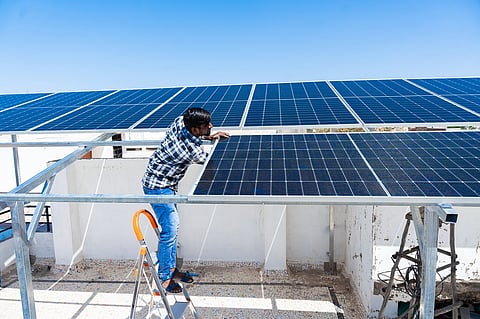

India is set to scale up its flagship PM-KUSUM solar pump scheme and replicate its success across developing nations, especially in Africa and small island states, through the International Solar Alliance (ISA).
The move is aimed at bringing irrigation access, energy security and clean power to millions in off-grid communities, reinforcing India’s role as a leader in distributed renewable energy, ISA director general Ashish Khanna said at the curtain raiser conference to the eighth assembly.
“The total percentage of arable land that is irrigated in Africa is just four per cent when that figure is about 60 per cent elsewhere,” he said, at the pre-assembly briefing. “Africa today imports food worth $400 billion even though it has huge arable land — because of absence of irrigation. So, all heads of state are looking for a solar pump story like PM-KUSUM. We are trying to create a large, aggregated platform of countries to support Africa in this way.”
The ISA is developing a financing and risk-mitigation framework to attract private investment in distributed renewable energy (DRE) projects. “If a private sector player wants to set up 1,000 mini-grids in Nigeria but faces problems raising equity or debt, our Africa Solar Facility will provide risk guarantee support,” the ISA director general explained.
The facility, based in Ahmedabad, aims to leverage $200 million by next year, mobilising 10–20 times that amount from private capital. It will serve as a catalytic finance instrument to help small island states and African nations deploy solar pumps, rooftop systems, and mini grids at scale.
India’s own experience with PM-KUSUM and PM Surya Ghar Muft Bijli Yojana has already transformed rural livelihoods. “Under PM Surya Ghar, more than 20 lakh households are benefiting from rooftop solar, said Union new and renewable energy minister Pralhad Joshi. “Through PM-KUSUM, India is targeting 10 GW of small solar plants, 1.4 million off-grid pumps, and 3.5 million grid-connected agricultural farms.”
India’s schemes have inspired interest from developing nations eager to bridge the gap between energy access and food security, Joshi added. “Both success stories of PM-KUSUM and PM Surya Ghar, we want to showcase in countries where connectivity is an issue. When success is shown, others will be encouraged. This is what we believe,” he said.
Beyond replication, the ISA is also aggregating demand among smaller economies to secure affordable procurement. “Small island states can do a lot of distributed solar but need to come together for scale. That’s why we’re enabling joint e-procurement platforms for solar and batteries,” Khanna added.
With the ISA now piloting solar digitisation in India, Brazil, and three African countries, officials say India’s experience offers a ready model for the Global South. As one speaker summed up, “India has shown what is possible. Through ISA, we will show the world that solar is not just the future — it is the only path forward.”